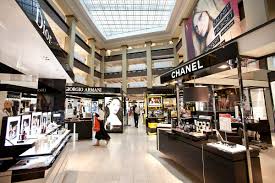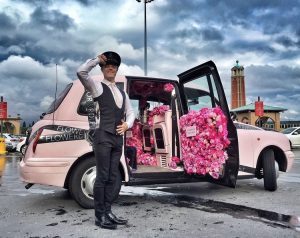Beauty Experiential, A Match Made In Avon
Face-to-face marketing and the beauty industry have always gone hand in hand, from direct-selling Avon representatives (there was a reason for the bad pun!), who, in a digital age, are moving, more and more, to digital channels; to brand ambassadors who work in retailers like Boots and Superdrug. It is this targeted focus on people rather than product, alongside the entrenched consumer perception of these products as necessities rather than luxuries, which makes this industry, one of the most effectively sold sectors in the history of marketing.
Beauty & Experiential
It is because of these “sociable” foundations that the beauty industry lends itself so well to experiential marketing, consumers associate the experience of shopping for make-up and perfume with the presence of a another party, advising them on what looks good, and it works!
This, combined with the nature of the products: portable, personal yet flexible, universally understood and uncontroversial; cuts out many of the logistical and engagement issues, plaguing other campaigns. It’s always fun to speculate, however, there are several other, more quantifiable, reasons as to why the beauty industry lends itself to experiential marketing.
Before we discuss them, it is worth acknowledging that 52% of beauty shoppers are influenced to make a purchase which is unplanned (Mintel); with sampling being the fourth biggest influencer of purchase decisions across all four biggest beauty categories (Euromonitor). It’s stats like these, which show that beauty consumers are ripe targets for experiential engagement.
Why use it?
Brand awareness
– Brand awareness is often the driving force of an experiential campaign. The nature of beauty products means they are easily sampled, which is a big draw, considering the typically premium price-tag associated with the industry and the comparatively brief time commitment in comparison to other installations, combined with immediate gratification.
Additionally, the goal of marketing is, of course, to ingrain a brand in a particular place in the consumer’s mind, this is another, innate, advantage of beauty products in experiential. Many beauty products appeal to the sense of smell; perfume, shampoo and body lotion for example, which research has discovered is closely linked with memory:
“there is now a significant body of literature on the role of the olfactory system (sense of smell) in memory and cognition,”
Sales uplift
– Experiential marketing is also effective at the point of sale, as seen by the number of product demonstrators in high-street cosmetics shops. Sales uplifts of up to 200% can be seen as a result of in-store sampling and product demonstrations.
This practise also cements relationships with distributors, which can lead to preferential treatment when it comes to product placement and promotion, all of which effect overall sales. This is not limited to face-to-face promotion either, 2 in 5 consumers reported interest in using an in-store tablet to research products available. (Mintel)
Expanding audiences or releasing new products
– Experiential is an effective tool to re-position an existing product, or bring a new one to the attention of the market. With the correct combination high footfall locations and timing, installations are perfectly suited to beauty products.
We detail, later in the article, ideas for the content of these installations, but in short, offering a professional service which would typically be costly as part of the campaign, e.g. professional make-up artists or manicures, will lead to consumers receiving value from the campaign and as such positively positioning your brand/product in their mind.
This feeds in to yet another benefit, the creation of content for social channels, both self-promoting and consumer-generated. By providing unique experiences, you give consumers a reason to talk about your brand outside of regular product discussions. According to Mintel: 71% of the beauty industry’s heaviest buyers use social media to help make purchase decisions.
How to use it!
Now the fun part, the creative nature of experiential marketing means that there will always be innovative new campaign ideas to try, but for now here’s 4 varied examples to check out.
PR stunt – previous example – Viktor & Rolf Flowerbomb taxi:
For the launch of the new Viktor & Rolf Flowerbomb fragrance, creative agency The Persuaders created a “flowerbomb taxi” to tour retail outlets throughout the UK complete with champagne bucket and flowery interior.
PR stunts are an effectively way of drawing attention to a new product launch or effort to re-brand, it leaves a lasting impression on consumers who engage and well executed campaigns are often the topic of social conversation and therefore “earned” promotion from brand advocates.
Interactive mirrors – previous example – Ralph Lauren interactive fitting room:
Trialed earlier this year in their NYC flagship store, Ralph Lauren equipped their fitting rooms with interactive mirrors to register the items the consumer is trying and display relevant details on-screen. They also include the functionality to call for assistance with a touch, or text “saved” items to a consumers phone.
Whilst this is an example from the fashion industry, the medium works equally well with beauty, because of the industry’s heavy reliance on mirrors. One campaign idea could use AR technology to allow consumers to see how shades of make-up look, without having to clean off and reapply multiple times.
In store promotion

Examples for this are commonplace, if you have visited a high-street cosmetics retailer you will have seen or experienced in-store promotion. However, campaigns should go above and beyond regular in-store samplings when a specific goal is in mind (which it should always be in marketing), like the launch of a new product. Tactics such as discounts across a range of other branded products with purchase are well received.
Additionally, entertainment such as in-store DJ’s, dancers or performers all resonate with key demographics, as well as generating interest and social media “buzz”. Capitalise on this social attention by running competitions based around sharing content from the event and offer rewards, such as a small sample, for sharing on social media.
One final thought to consider is involving industry influencers to promote your content via their social channels, Snapchat and Instagram are two of the most underused mediums in marketing and yet present the perfect platforms to appeal to the 18-30 market. Snapchat receives 10 billion daily video views (expandedramblings), whilst Instagram has over 14 million active users in the UK alone (expandedramblings), targeting key influencers in these markets can provide unparalleled reach for campaigns.
Installation
An installation in a high footfall area like a shopping centre can also be a huge draw for engagement. Pop-up salons, for example, where consumers can come to receive a free treatment or service, which ordinarily would have a premium price-tag (make-over, manicure or face mask are all good examples).
The key to any content is creating value for the consumer, consumers who feel they receive exceptional value are the most likely to spread word-of-mouth or “earned” promotion about your brand through their social channels. Don’t feel restricted by your medium, get creative, an innovative example of a similar installation for a perfume brand could be a flower garden, where the flowers contain samples of different fragrances, being different is a prerequisite of creating engaging content.
By now, you should have: an idea of why experiential can be so effective in the beauty industry; as well as several jump-off points to structure campaign ideas around. If this article hasn’t convinced you that experiential is the right thing for your beauty product, perhaps this quote from Hilary Monk, senior retail analyst at Mintel, will sway you:
“Spending on beauty and personal care contracted marginally in 2015. The market remains very price sensitive and discount retailers’ customer numbers grew significantly. Even buyers of prestige brands are price conscious. The market will recover in 2016 but premium retailers must give consumers original and compelling reasons to trade up.”
If we’ve inspired you to try experiential marketing, let us help! For your promotional staffing & experiential needs, contact us today!
